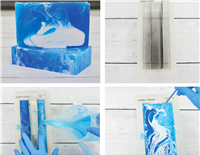Tutorial: Swirling Melt & Pour SoapUpdated a year ago
Helpful tips and Tricks:
Make Dividers: A key to swirling melt and pour soap is to keep your colors separate until they are just the right temperature to swirl. Dividers in your mold drastically help with this! Use a stiff wax covered paper to create the dividers, here we used a file folder. They should fit snugly lengthwise in your loaf mold and at least two inches taller than the mold. The height allows for easy removal later.
Choose Your Colors Wisely: At least one contrasting color is important to achieve a vivid melt and pour swirl. We find that using two vibrant colors in clear soap base and the third color as white soap base consistently produces stunning swirled designs. Separate and color your soap into three different containers with your fragrance of choice.
Juggling Soap Temperatures: The best swirled designs happen when all three soap bases are roughly the same temperature when pouring. This becomes increasingly difficult if you only have one microwave! Melt each soap being extra careful not to overheat any of the colors. We recommend getting the soaps to 140ºF each. If you have the ability, 3 separate double boilers can help achieve a consistent temperature for the soap bases.
Putting It All Together: While holding the dividers in place, pour the most contrasting soap color into the middle section at a temperature of 125ºF to 130ºF. Only pour 1/4” to 1/2” high. Move to the sides by filling each side section with a different soap color matching the level you poured in the middle. Continue filling in this manner until you have reached the top. Carefully remove the dividers. Use a skewer to zig-zag your way through the loaf from end to end. When you reach the end move the skewer along the edges of the mold and remove the skewer and any clumps that may have accumulated on the skewer. Allow to harden, then un-mold and slice as usual.
